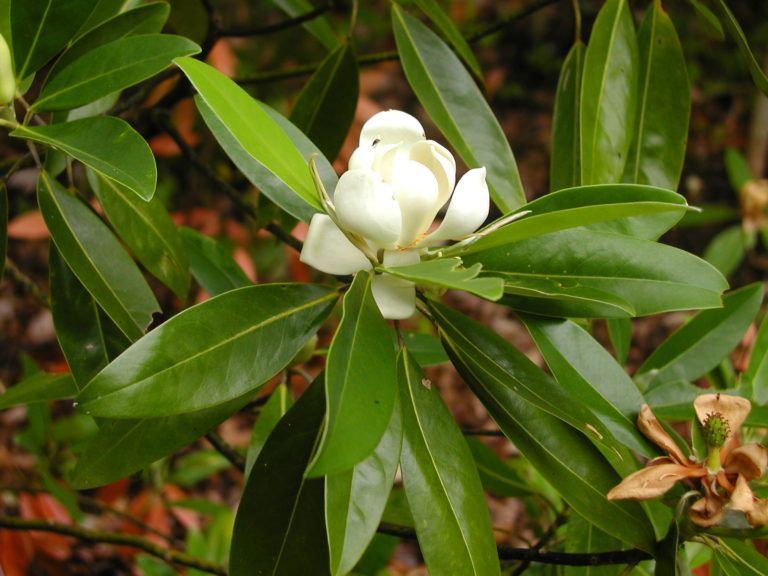Magnolia virginiana, or Sweetbay Magnolia, is a small tree or shrub at home in the Atlantic and Gulf Coastal Plains and piedmont as far north as New York.. With 3- to 5-inch, oval, leathery green leaves with silvery undersides, and beautiful, sweetly-scented, small (3″ wide) ivory flowers in spring and summer, followed by showy red seed cones in fall, Sweetbay is a wonderful plant to have around. If can be grown with several stems, and will blend in to a shrub border, or as an upright, single-leader specimen yard tree with a wide-columnar form. Sweetbay is different from other magnolias in that it can tolerate saturated and flooded soils as well as droughty conditions, making it an excellent candidate for a rain garden. It can grow for 50 years. There is disagreement as to its ultimate height, as a southern natural variety, M. virginiana ‘australis’ is truly evergreen and grows to an unapologetic 60′. The largest known specimen of Magnolia virginiana (the evergreen form), 28m (= 92 feet) in height with a trunk diameter of 1.4 m (=4.6 feet), is recorded from Union County, Arkansas (American Forestry Association 1994). In the Northern part of its range, reports range from 20′ to 40′, and we have only seen 20-foot specimens in our area in the central NC piedmont.
NURSERY HOURS
Wednesday: 10-4 Thursday: 10-6 Friday-Saturday: 10-4 Sunday: 12-4
Magnolia virginiana

Key Info
Common Names: Sweet Bay Magnolia, Swamp magnolia, Beaver Tree, Laurel Magnolia, Swamp Bay, White Bay
Family Names: Magnoliaceae
Plant Type: Tree / Shrub
Leaf Retention: Evergreen in southern parts of its range
Flower Color: White
Special Characteristics: Tolerates dry conditions, Long blooming period, Showy fruit, Flowers fragrant, Attracts birds, Leaves fragrant, Tolerates wet conditions
Additional Info
Habit: Grows either as a medium-textured, single-stemmed tree with an upright oval growth habit or or as a large, multi-stemmed shrub with a rounded crown, first year stems green turning to gray thereafter.
Height: 15' to 20'
Spread: 15' to 20'
Soil Conditions: moist well drained to saturated, wet; acidic pH, rich, organic loamy, sandy, silty loam, clay
Leaves: Waxy, alternate, elliptical, entire, simple leaves 3–5" in length with pinnate venation, dark green and lustrous on top with a silvery underside.with a wedge-shaped base and bluntly point apex.
Flowers (or reproductive structures: Monoecious; creamy white flowers with large numbers of reproductive parts; sweetly scented.
Fruit: Solid green, somewhat contorted, cone-like aggregate fruits develop into chartreuse-to-brown, woody fruits, exposing many interior ¼-inch long bright, oval red seed in late summer, July to October. The seed remains attached to the open pod by a thin, elastic thread (plants.usda.gov/plantguide).
Natural Distribution: rich woods, wood edges, meadows, swamps, bays, pocosins
USDA Hardiness Zone: 6 to 10
USDA Wetland Indicator Status in NC: FACW
Pollination: The flowers are pollinated by beetles, and open and close in a 2-day flowering cycle, alternating between a female and male pollination phase. These separate phases prevent the flower from self-pollinating; however, separate flowers on the same plant may cross-pollinate (plants.usda.gov/plantguide).
Wildlife Connections: The fruit is eaten by gray squirrels, white-footed mice, turkey and quail as well as a variety of songbirds including Vireos, Towhees, Northern Flicker and Blue Jays. The tree benefits wildlife by providing cover and nesting sites. It is a larval host for the Sweetbay Silkmoth. Early American settlers called it “beaver tree” because the fleshy roots made good bait for beaver traps (gardeningknowhow.com).
Propagation: By seeds.
